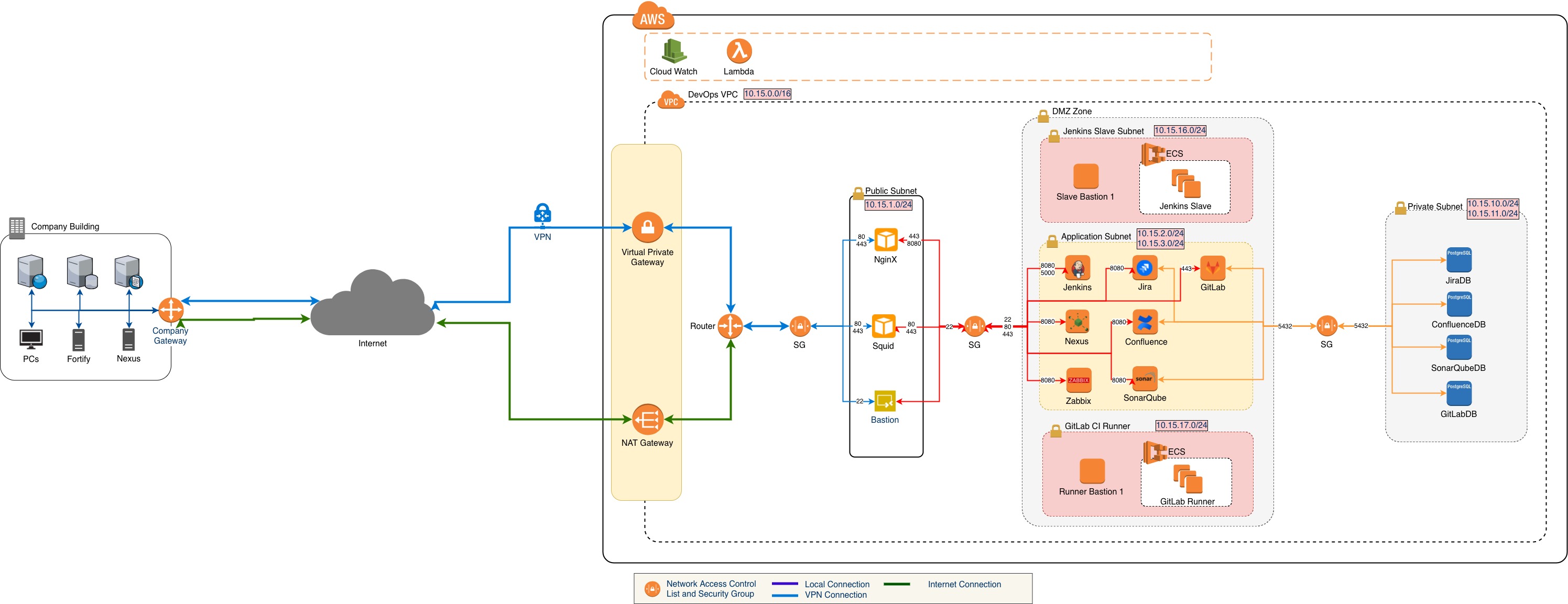This project buiding on frameworks:
- Terraform
- Ansible
- Create network base on Architecture
- VPC: 10.15.0.0/16
- Subnet: 7 subnets (1 public subnet, 2 application subnets, 2 agent subnets, 2 private subnets)
- Router table: Internet > DevOps via Internet gateway, DevOps > Internet via NAT Gateway
- Gateway: Internet Gateway and NAT Gateway
- Security Group: Update inbound and outbound for all server
- EIP: only NAT gateway and NginX server have EIP
- Create Instances will using as Architecture
- Create script for auto install applications
- Bastion
- NginX
- Jira
- Squid
- Confluence
- Sonarqube
- GitLab
- Jenkins
- Nexus Repository
- OpenLdap
- Lambda function for auto turn-on and turn-off AWS Instances
To install Terraform, find the appropriate package for your system and download it. Terraform is packaged as a zip archive.
Another way, you can install by the below way:
- Install Terraform on MacOS
brew install terraform
- Install Terraform on Centos 7
First up, you will need to upgrade your system and packages to current version:
$ sudo yum update
Next, we will install wget and unzip packages if they’re not already installed:
$ sudo yum install wget unzip
Now we are ready to download Terraform zip file for Linux from the official website. At the time of writing this article, the current version of Terraform was 0.12.5.
$ wget https://releases.hashicorp.com/terraform/0.12.5/terraform_0.12.5_linux_amd64.zip
Next, we will unpack the archive to /usr/local/bin/
$ sudo unzip ./terraform_0.12.5_linux_amd64.zip -d /usr/local/bin/
- Install Terraform on Ubuntu 18.04
To update the system and packages, you can use the built-in software updater, or manually update the system with:
$ sudo apt-get update
Again, we will install wget and unzip packages if they’re not already installed:
$ sudo apt-get install wget unzip
Also next, we will run the same commands as we did with CentOS 7:
$ wget https://releases.hashicorp.com/terraform/0.12.5/terraform_0.12.5_linux_amd64.zip
$ sudo unzip ./terraform_0.12.5_linux_amd64.zip -d /usr/local/bin/
And finally, to test if our installation was successful:
$ terraform -v
Chef InSpec requires Ruby ( >= 2.4 ).
- The Chef InSpec package is available for MacOS, RedHat, Ubuntu and Windows. Download the latest package at Chef InSpec Downloads or install Chef InSpec via script:
# RedHat, Ubuntu, and macOS
curl https://omnitruck.chef.io/install.sh | sudo bash -s -- -P inspec
# Windows
. { iwr -useb https://omnitruck.chef.io/install.ps1 } | iex; install -project inspec
- Install it via
rubygems.org
When installing from source, gem dependencies may require ruby build tools to be installed.
For CentOS/RedHat/Fedora:
yum -y install ruby ruby-devel make gcc gcc-c++
For Ubuntu:
apt-get -y install ruby ruby-dev gcc g++ make
To install the inspec executable, which requires accepting the Chef License, run:
gem install inspec-bin
You may also use inspec as a library, with no executable. This does not require accepting the license. To install the library as a gem, run:
gem install inspec
Create or edit file ~/.aws/credentials file and add below content to that file:
[default]
aws_access_key_id = aaaaaa
aws_secret_access_key = bbbbbbb
with
defaultis default profile. Terraform default using this profile for creating infrastructure on AWSaaaaaais access keybbbbbbbis secret access key
